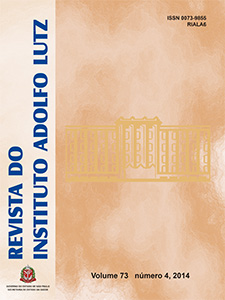Abstract
Some species of wild birds have been identified as reservoirs of Campylobacter e Salmonella, they may exert as disseminators of these microorganisms. However, in Brazil, there is no study on the role of wild birds in the transmission of these two pathogens. This study aimed at searching the occurrence of Campylobacter and Salmonella in wild birds that feed in the rice paddies. By using mist nets 23 garibaldis (Chrysomus ruficapillus), one rolinha-picuí (Columbina picui) and one canário-da-terra (Sicalis flaveola) were captured. The birds stool samples were collected using swabs, and they were processed for searching Campylobacter spp. and Salmonella enterica. Eight (32 %) fecal samples collected from C. ruficapillus were Campylobacter-positive and six (24 %) were positive to Salmonella enterica; five (20 %) samples collected from C. ruficapillus and one (4%) from S. flaveola were positive to Salmonella enterica. The two birds C. ruficapillus and S. flaveola showed to be reservoirs of Campylobacter and Salmonella, and they can be potential transmitters of these pathogens. This study is the first report on the isolation of Campylobacter and Salmonella from wild birds C. ruficapillus and S. flaveola.References
1. Germano PML, Germano MIS. Agentes bacterianos de toxinfecções. In: Germano PML, Germano, MIS. Higiene e Vigilância Sanitária de Alimentos. 2ª Edição. São Paulo: Editora Varela; 2003, p. 215-75.
2. Centers for Disease Control and Prevention [CDC]. Vital Signs: Incidence and Trends of Infection with Pathogens Transmitted Commonly Through Food - Foodborne Diseases Active Surveillance Network, 10 U.S. Sites, 1996--2010.Morb Mortal Wkly Rep. 2011;60(22):749-55.
3. Brasil. Ministério da Saúde. Secretaria de Vigilância em Saúde. Coordenação Geral de Doenças Transmissíveis. Unidade de Doenças de Veiculação Hídrica e Alimentar, 2011. Vigilância Epidemiológica das Doenças de Transmissão Hídrica e Alimentar –VEDTHA. Disponível em: [http://portal.saude.gov.br/portal/arquivos/pdf/10_passos_para_investigacao_surtos.pdf].
4. Kapperud G, Rosef O. Avian wildlife reservoir of Campylobacter fetus subsp. jejuni, Yersinia spp. and Salmonella spp. in Norway. Appl Environ Microbiol. 1983:375-80.
5. Rosef O, Kapperud G, Lauwers S, Gondrosen B. Serotyping of Campylobacter jejuni, Campylobacter coli and Campylobacterlaridis from domestic and wild animals. Appl Environ Microbiol. 1985;49(6):1507-10.
6. Tsiodras S, Kelesidis T, Kelesidis I, Bauchinger U, Falagas ME. Human infection associated with wild birds. J Infect. 2008;56(2):83-98.
7. Dias RA, Burger MI. A assembléia de aves de áreas úmidas em dois sistemas de cultivo de arroz irrigado no extremo sul do Brasil. Ararajuba. 2005;13(1):63-80.
8. Comitê Brasileiro de Registros Ornitológicos [CBRO]. Listas das Aves do Brasil, 10ª ed., 2011. Disponível em: [http://www.cbro.org.br].
9. George HA, Hoffmann PS, Krieg NR, Smimbert RM. Improved media for growth and aerotolerance of Campylobacter fetus. J Clin Microbiol. 1978;8:36-41.
10. Filgueiras ALL, Hofer E. Ocorrência de Campylobacter termofilico em diferentes pontos de uma estação de tratamento de esgotos na cidade do Rio de Janeiro. Rev Microbiol. 1989;20:303-8.
11. Attebery HR, Finegold SM. A miniature anaerobic jar for tissue transport or for cultivation of anaerobes. Am J Clin Pathol.1970;53:383-8.
12. Andrews WH, Jacobson W, Hammack T. Salmonella. U.S. Food and Drug Administration, Bacteriological analytical manual, Chapter 5, 2011. Disponível em: [http://www.fda.gov/Food/FoodScienceResearch/LaboratoryMethods/ucm070149.htm].
13. Gonçalves GAM, Almeida SM, Camossi LG, Langoni H, Andreatti Filho RL. Avaliação sorológica de Parainfluenzavirus tipo 1, Salmonella spp., Mycoplasma spp. e Toxoplasma gondii em aves silvestres. Cienc Anim Bras. 2013:14(4):473-80.
14. Lopes ES, Cardoso WM, Albuquerque AH, Teixeira RSC, Salles RPR, Bezerra WGA, et al. Isolation of Salmonella spp. in captive Psittaciformes from zoos and a commercial establishment of Fortaleza, Brazil. Arq Bras Med Vet Zootec. 2014:66(3):965-8.
15. Santos HF, Flôres ML, Lara VM, Silva MS, Battisti L, Lovato LT.Microbiota cloacal aeróbia de cracídeos cativos no Rio Grande do Sul e sua susceptibilidade a antimicrobianos. Pesq Vet Bras. 2010:30(12):1077-82.

This work is licensed under a Creative Commons Attribution 4.0 International License.
Copyright (c) 2015 Instituto Adolfo Lutz Journal
